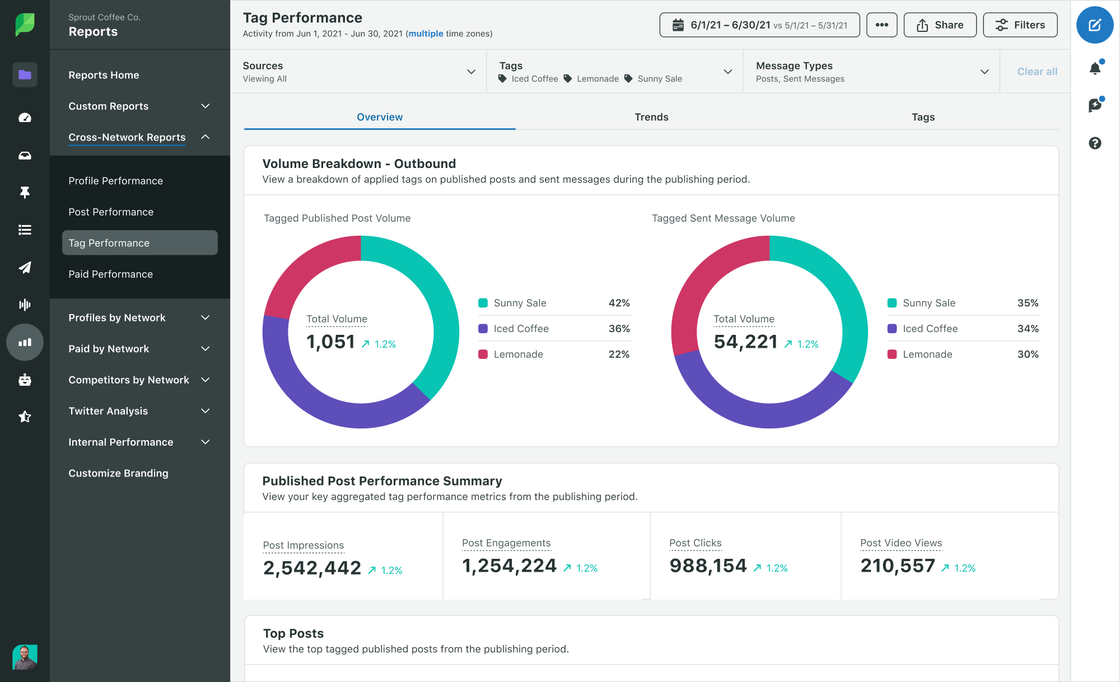Social media governance for EU businesses: 5 ways to protect your brand

Table of Contents
Please note: The information in this article does not, and is not intended to, constitute formal legal advice. Please review our full disclaimer before reading any further.
Social moves fast. When teams publish across social networks and time zones, staying consistent and compliant takes more than speed—it also requires structure.
Social media governance and crisis communications plans help you stay ahead. The most resilient brands treat these not just as risk mitigation but also as a competitive advantage in strengthening their online presence and brand reputation.
What is social media governance?
Social media governance, also known as social media policy, is your brand’s framework for managing its online presence. It sets out clear guidelines for everyone, defining roles and processes to ensure your social activity remains consistent, on-brand and helps you reach business goals. It supports safer decision-making across all social media activities, from reputation management to influencer campaigns.
When regulations, brand equity and public perception are deeply intertwined, social media governance becomes the foundation for long-term brand trust and consistency.
How a social media governance plan differs from social media strategy
Your social media policy is different from your social strategy—and it’s crucial to treat them as such. Here are the differences between the two:
- Governance is operational and risk-focused. It ensures that your team follows the rules of the road, especially when that road includes regulations, risk management protocols and real-time crisis management.
- Strategy is proactive. It defines your goals, key audiences and content pillars and provides a roadmap for how you’ll grow awareness, engagement and impact through social media marketing.
Think of it this way: If strategy is about the “what” and “why,” governance is about the “how” and “who.”
A well-documented social media governance plan brings consistency, transparency and trust to your social programme. It also defines:
- Roles and responsibilities across departments and agency partners
- Approval and escalation workflows to handle high-risk content or social media crises
- Platform-level permissions that control access to multiple social media accounts
- Auditable processes that ensure compliance with data protection regulations like GDPR
In contrast, your strategy outlines:
- Channel mix and content themes
- Audience personas and messaging
- KPIs and benchmarks to track performance
- Campaign plans to meet business goals
Both governance and strategy are essential. But without governance, even the most ambitious strategy risks errors, inefficiencies or other red flags.
7 risks of not prioritising social media governance
Strong governance enables agility and consistency. Without it, even minor oversights can escalate into brand or legal crises.
These are some risks you may run if you don’t factor in governance:
1. Brand damage from off-brand or unsanctioned content
When teams move quickly, it’s easy for them to publish content without proper review. A well-meaning meme at the wrong time, for instance, can cause confusion or undermine brand trust.
Sprout’s approval workflows and shared content calendar give your team the visibility and control they need to align on messaging, timing and compliance before anything goes live. This is especially crucial for paid partnerships or influencer campaigns where ASA disclosures are a must.
2. Regulatory compliance issues
Poor data management or unclear influencer partnerships can land you in trouble with the ASA and lead to GDPR violations. But more importantly, they can slowly chip away at your audience’s trust too.
Social media management tools often include features to help you navigate regulatory compliance. Guardian by Sprout Social helps you manage data securely, without slowing your team down. It uses AI-driven tools to reduce risk, remove friction and enhance the customer experience, which helps you stay compliant and efficient.
Key capabilities include the following:
- Blocked words: Allows you to set proactive filters to prevent off-brand or non-compliant responses before you publish them
- Data masking: Automatically hides sensitive information from direct messages in the Smart Inbox
- Secure forms: Helps you collect personal customer data like payment or account details without compromising privacy
These tools, alongside Sprout’s role-based permissions and detailed audit trails, document every action and ensure that every team member has the right level of access and your brand remains protected at every stage.
3. Inconsistent brand voice across channels or teams
When teams work in isolation, your brand voice can quickly become inconsistent. For instance, one channel might sound playful, while another feels overly formal, leading to mixed messages and a diluted brand identity.
In contrast, brands with strong governance keep their tone consistent across channels. Wendy’s UK is a great example—whether it’s on TikTok, X or Instagram, its posts strike the same playful, slightly cheeky tone every time, building familiarity and trust with every interaction.
(Source: TikTok)
(Source: Instagram)
To address this challenge, Sprout unifies messaging through its shared asset library and content calendar. This gives teams real-time access to approved visuals, templates and scheduling tools so they can create on-brand content faster, stay consistent across campaigns and cut down on back-and-forth.
With brand sentiment insights layered into reporting, you can continuously track how consistency (or a lack thereof) impacts audience perception and engagement. This strengthens your online presence and preserves a unified brand reputation across all social media activities.
4. Slower crisis responses
Speed makes all the difference in a crisis. When your team knows exactly who to loop in, where to find assets and how to respond, they can move quickly and confidently. This minimises confusion and keeps your brand on track.
Sprout’s calendar controls, shared folders and pre-approved response libraries give you a head start. Instead of scrambling, teams can respond swiftly with coordinated crisis management processes.
5. Cross-functional misalignment
When teams work from the same systems, everything runs smoother. Approvals move faster, messaging stays consistent and no one finds themselves out of the loop.
Shared campaign planning tools make collaboration seamless across departments.That way, everyone stays aligned and accountable—from brand to comms to legal—so your campaigns launch on time and on message.
6. No content guardrails
When your social media team lacks visibility into who’s doing what, it’s not just strategy that slips, it’s accountability. Without clear roles, approval workflows and audit trails, it’s easy for mistakes to happen and even easier to miss critical issues. That kind of ambiguity can put your brand at risk.
However, Premium Analytics helps you bring order to the chaos. With team-level reporting and user activity logs, you can see exactly how your team is working, including what they’re publishing, who approved it and when. It’s this kind of oversight that makes governance feel less like red tape and more like peace of mind.

7. Stale governance policies
Social evolves fast, which means you need to change right along with it. Static policies often create more confusion than clarity. If your governance policies still reference Facebook Live as an innovation, for instance, it’s time for a refresh.
To do this, run quarterly governance audits and align workflows with current trends, tools and compliance expectations. Making governance a living system will help you keep pace with changing algorithms, channel formats and regulatory shifts.
You can also pair your governance audits with employee training initiatives. This ensures that your social teams and collaborators understand the latest guidelines and how to apply them.
5 best practices to strengthen your social media governance
Governance doesn’t need to slow you down. These five steps will help you scale your social media management programme with confidence:
1. Define clear roles and approval workflows
When publishing authority is vague, things will inevitably go wrong. Posts may launch without approval, legal might not be present during crisis response—and ultimately, ownership falls through the cracks.
To help with this, social media marketing tools offer multi-step approval workflows and custom user roles let you assign responsibilities clearly, from drafting to publishing. This way, everyone knows their role, which leads to higher content quality, faster approvals and fewer social media risk scenarios.
2. Set up secure access controls and audit visibility
Access control isn’t just part of social media security—it’s also a compliance essential.
With the UK’s new Data (Use and Access) Act 2025 now in force, brands need to be more intentional about who has access to what, when and why. The Act introduces stronger consumer rights and clearer enforcement standards, which makes it more important than ever to have documented permissions in place.
Sprout’s role-based permissions and automated audit logs help you meet those standards. With them, you get a full record of who posted what and when, which supports SOC 2 alignment and GDPR-compliant governance. It also helps you prepare for new requirements under the Act, including data access transparency, digital ID authentication and user complaint handling.
3. Standardise brand guidelines and approved content assets
Consistency starts with access to the right assets. When teams can’t find approved logos, templates or tone guidance, they default to guesswork.
To prevent this from happening, Sprout provides an asset library that gives teams a single, searchable source of truth so everyone publishes with confidence and consistency. This ensures that your social media content stays aligned with brand values and doesn’t put your online presence at risk.
4. Plan for real-time escalation with crisis-ready workflows
Even with a clear social media policy in place, unexpected challenges can still surface. How you respond in the moment will ultimately shape how people perceive your brand long-term.
But crisis readiness isn’t just about having rules on paper. It also involves creating workflows that unite teams around a coordinated, real-time response. As a result, your policy should define personal versus business use, as well as outline who’s responsible for what when things move fast.
When public-facing employees share personal views that don’t reflect company values, it often exposes a common gap: vague boundaries and no clear plan for the reputational risks of personal social use. A strong policy removes that grey area by clearly setting expectations and consequences that protect both your people and your brand.
However, UK law firm Lewis Silkin advises against zero-tolerance policies. Instead, they recommend weighing factors like tone, context and whether other users might reasonably associate the brand with the post.
To aid in this, Sprout’s Listening tool helps you spot sentiment shifts early so you can address potential issues before they gain traction. Combine that with Smart Inbox prioritisation and saved replies to respond quickly, consistently and with confidence—no matter the situation.
5. Review and evolve your governance with regular audits
Platform policies and team structures change fast, as do trends on each platform—so what worked last year may not work today. That’s why your governance plan should be a living framework, built to adapt as your organisation grows.
Rather than focusing on control, reframe the conversation around enablement: How are you equipping employees to represent your brand safely, confidently and in line with your values?
Regular audits are your chance to close that gap. You can use them to:
- Revisit your social media policy to reflect new tools, channels or risks
- Evaluate access controls, platform permissions and approval workflows
- Align with IT and legal teams to ensure compliance and data protection
- Gather feedback from social practitioners and employee advocates to surface real-world needs
Most importantly, you should make your governance plan actionable. After all, a strong social media policy should empower, not restrict, your team.
Build trust through effective governance
Social media governance is all about how modern brands scale strategy, align teams and build long-term trust. When marketing, legal, comms and social all operate from the same playbook, brands speak with one voice and move with purpose.
Ready to operationalise your governance strategy? Start your free trial of Sprout Social today and explore tools to help you manage risk and unlock smarter, safer social publishing.
DISCLAIMER
The information provided in this article does not, and is not intended to, constitute formal legal advice; all information, content, points and materials are for general informational purposes. Information on this website may not constitute the most up-to-date legal or other information. Incorporation of any guidelines provided in this article does not guarantee that your legal risk is reduced. Readers of this article should contact their legal team or attorney to obtain advice with respect to any particular legal matter and should refrain from acting on the basis of information on this article without first seeking independent legal advice. Use of, and access to, this article or any of the links or resources contained within the site do not create an attorney-client relationship between the reader, user or browser and any contributors or contributing law firms. The views expressed by any contributors to this article are their own and do not reflect the views of Sprout Social. All liability with respect to actions taken or not taken based on the contents of this article are hereby expressly disclaimed.




Share